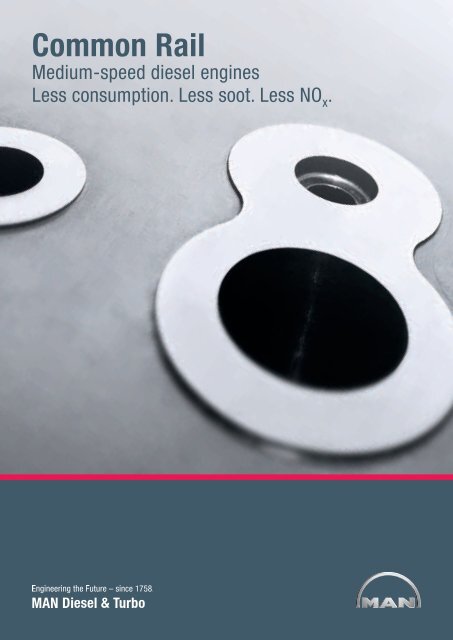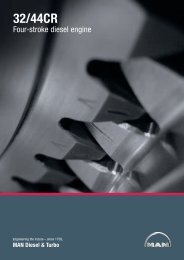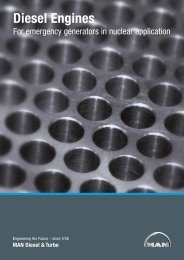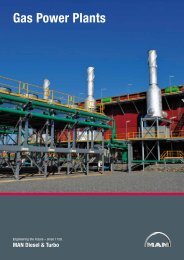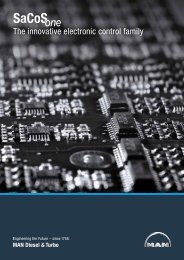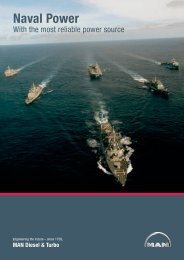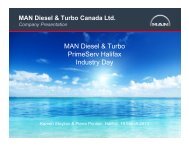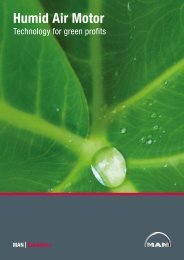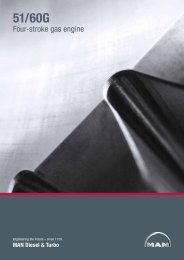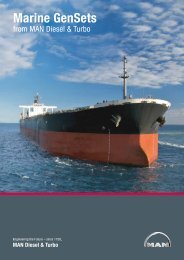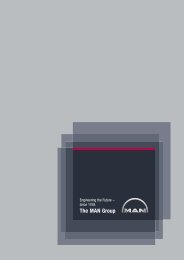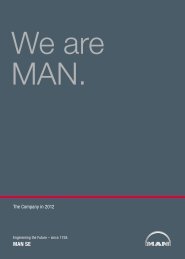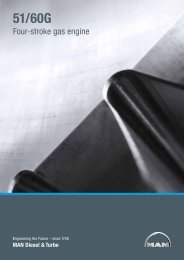Common Rail - MAN Diesel & Turbo Canada
Common Rail - MAN Diesel & Turbo Canada
Common Rail - MAN Diesel & Turbo Canada
You also want an ePaper? Increase the reach of your titles
YUMPU automatically turns print PDFs into web optimized ePapers that Google loves.
<strong>Common</strong> <strong>Rail</strong><br />
Medium-speed diesel engines<br />
Less consumption. Less soot. Less NO x .
<strong>MAN</strong> <strong>Diesel</strong> & <strong>Turbo</strong><br />
The responsible way in leading technology<br />
<strong>MAN</strong> <strong>Diesel</strong> & <strong>Turbo</strong> is the world’s leading designer and manufacturer of low and<br />
medium speed engines – engines from <strong>MAN</strong> <strong>Diesel</strong> & <strong>Turbo</strong> cover an estimated 50%<br />
of the power needed for all world trade. We develop two-stroke and four-stroke<br />
engines, auxi liary engines, turbochargers and propulsion packages that are manufactured<br />
both within the <strong>MAN</strong> <strong>Diesel</strong> & <strong>Turbo</strong> Group and at our licensees.<br />
More than ever before, <strong>MAN</strong> <strong>Diesel</strong> & <strong>Turbo</strong>’s development focus is the environmental<br />
performance of our engines. Using our unrivalled grasp of large engine technology,<br />
we aim to make our engines progressively cleaner, more powerful and more efficient.<br />
Our absolute commitment to reducing emissions while increasing fuel efficiency<br />
and power density starts with our active partnership in the emissions law making<br />
process and ends with the delivery of engines that achieve an ideal synthesis of<br />
prime mover characteristics.<br />
<strong>Common</strong> <strong>Rail</strong> – Less consumption. Less soot. Less NO x .<br />
3
Injection Technology<br />
Medium-speed four-stroke engines<br />
The coming decades will see a sharp increase in the ecological and economic<br />
demands placed on internal combustion engines. Evidence of this trend is the<br />
yearly tightening of emissions standards worldwide, a development that aims not<br />
only at improving fuel economy but above all at achieving clean combustion that<br />
is low in emissions.<br />
Large reductions in NO X , CO 2 and soot emissions are a<br />
strategic success factor for HFO diesel engines. Special<br />
emphasis is placed on low load operation, where conventional<br />
injection leaves little room for optimisation since<br />
the injection process, controlled by the camshaft, is linked<br />
to the engine speed. Thus, possibilities for designing a<br />
load independent approach to the combustion process<br />
are severely limited.<br />
<strong>MAN</strong> <strong>Diesel</strong> & <strong>Turbo</strong> <strong>Common</strong> <strong>Rail</strong> Technology (CR)<br />
severs this link in medium-speed four-stroke engines.<br />
CR permits con tinuous and load-independent control<br />
of injection timing, injection pressure and injection volume.<br />
Thus, CR techno logy achieves the highest levels<br />
of flexibility for all load ranges and yields significantly<br />
better results than any conventional injection system.<br />
<strong>MAN</strong> <strong>Diesel</strong> & <strong>Turbo</strong> now offers a reliable and efficient<br />
CR technology for the wide range of different types of<br />
fuel, also capable to handle residual fuels (HFO).<br />
L 32/44CR<br />
4 <strong>Common</strong> <strong>Rail</strong> – Less consumption. Less soot. Less NO x . <strong>Common</strong> <strong>Rail</strong> – Less consumption. Less soot. Less NO x .<br />
5
<strong>MAN</strong> <strong>Diesel</strong> & <strong>Turbo</strong> CR Technology<br />
Measurably friendly to the environment<br />
General Benefits<br />
<strong>Common</strong> rail technology<br />
Comparison of engine performance for different<br />
injection systems<br />
<strong>MAN</strong> <strong>Diesel</strong> & <strong>Turbo</strong> <strong>Common</strong> <strong>Rail</strong> Technology lowers<br />
the emission rate of soot and NO x at all possible engine<br />
operating points.<br />
CR unit<br />
injector<br />
Soot Emissions<br />
FSN<br />
The graph shown here compares conventional and CR<br />
0.7<br />
0.6<br />
0.5<br />
0.4<br />
0.3<br />
0.2<br />
0.1<br />
injection processes exemplary.<br />
Due to the flexibility of the injection process, NO x emission,<br />
fuel consumption and exhaust opacity can be<br />
improved by varying injection pressure and start of injection.<br />
Even in the commonly problematic low load<br />
range, exhaust opacity can be brought down below<br />
the visibility limit.<br />
high pressure pump<br />
camshaft<br />
0 25 50 75 100<br />
Engine Load (%)<br />
Higher efficiency with flexible injection<br />
Our CR technology is an ideal tool for lowering pollu-<br />
NO x<br />
The old problem with the fixed link between injection<br />
tant emissions and fuel consumption – while giving the<br />
%<br />
pressure and engine speed is well-known. In engines<br />
user the security that this system will continue to meet<br />
104<br />
100<br />
96<br />
92<br />
88<br />
with high effective mean pressure, there is a rapid decline<br />
in injection pressure in the low load range, a phenomenon<br />
that has a negative effect on the air-to-fuel ratio<br />
and on spray atomisation that are key to combustion.<br />
Poor combustion is the consequence.<br />
the demands of the future: today’s diesel engine designs<br />
at <strong>MAN</strong> <strong>Diesel</strong> & <strong>Turbo</strong> already include potential to<br />
meet tomorrow’s requirements.<br />
Retrofit? Retrofit!<br />
CR technology from <strong>MAN</strong> <strong>Diesel</strong> & <strong>Turbo</strong> takes advan-<br />
0 25 50 75 100<br />
The new <strong>MAN</strong> <strong>Diesel</strong> & <strong>Turbo</strong> CR injection technology<br />
tage of a modular high pressure pump system with<br />
Engine Load (%)<br />
permits independent and separate control of injection<br />
multiple lobes on the camshaft. The camshaft drives<br />
pressure and timing. Fuel is fed into the rail (pressure<br />
the high pressure pumps, which are equipped with<br />
SFOC<br />
accumulator) by an electronically controlled high pres-<br />
solenoid operated suction throttle valves for pressure<br />
%<br />
sure pump and stored there for each injection. The<br />
control. This layout – and the modular structure of the<br />
100.5<br />
100.0<br />
99.5<br />
99.0<br />
98.5<br />
98.0<br />
result is improved combustion and lower emissions<br />
with the same or even better fuel economy – strong<br />
advantages, especially in the critical low load range.<br />
Doing more for the environment<br />
The injection flexibility of <strong>MAN</strong> <strong>Diesel</strong> & <strong>Turbo</strong> CR technology<br />
means decidedly lower NO X and CO 2 emissions<br />
units – makes it possible to install <strong>MAN</strong> <strong>Diesel</strong> & <strong>Turbo</strong><br />
CR technology retrospectively. Thus, many older diesel<br />
engines can still benefit from the new technology: simple,<br />
fast retrofitting and upgrading – for lower emissions with<br />
no loss in output.<br />
0 25 50 75 100<br />
thanks to highly effective combustion.<br />
Engine Load (%)<br />
Conventional Injection<br />
CR Injection<br />
6 <strong>Common</strong> <strong>Rail</strong> – Less consumption. Less soot. Less NO x . <strong>Common</strong> <strong>Rail</strong> – Less consumption. Less soot. Less NO x .<br />
7
Enhancing Reliability<br />
Thinking ahead<br />
<strong>MAN</strong> <strong>Diesel</strong> & <strong>Turbo</strong> CR injection technology is synonymous with reliability – and<br />
reliability begins at the development process.<br />
<strong>MAN</strong> <strong>Diesel</strong> & <strong>Turbo</strong>’s experience in the development and<br />
production of high pressure injection systems has been<br />
consistently advanced and implemented in CR technology.<br />
In addition to theoretical investigations of safety<br />
concept, test operations with HFO on <strong>MAN</strong> <strong>Diesel</strong> & <strong>Turbo</strong><br />
system test rigs are of central importance and make it<br />
possible to immediately define any preventive measures<br />
required to guard against potential technical problems.<br />
Field tests were conducted, which showed very satisfactory<br />
long-term experience in respect of wear and<br />
component reliability. Consequently, CR technology<br />
from <strong>MAN</strong> <strong>Diesel</strong> & <strong>Turbo</strong> is able to offer excellent reliability<br />
in all operating situations and, from the outset,<br />
brings with it a high degree of maturity.<br />
For example<br />
Should a high pressure pump fail:<br />
<strong>MAN</strong> <strong>Diesel</strong> & <strong>Turbo</strong> CR systems are equipped with<br />
at least two high pressure pumps and the system can<br />
easily be operated with only one high pressure pump.<br />
Should the rail pressure controller fail:<br />
A safety valve with an additional mechanical pressure<br />
control valve ensures the continued operability of the<br />
system.<br />
Should a rail pressure sensor or the speed /<br />
top dead centre sensor malfunction:<br />
Important sensors are redundant to ensure that here,<br />
too, the system will continue to operate.<br />
To protect against fuel escaping from<br />
leaking fuel pipes:<br />
All high pressure lines, rails and high pressure connections<br />
are double wall insulated.<br />
To protect against uncontrolled injections:<br />
Flow limitation valves at each cylinder prevent uninten-<br />
ded injection.<br />
As a matter of principle, <strong>MAN</strong> <strong>Diesel</strong> & <strong>Turbo</strong> has kept<br />
the basic concept of its <strong>Common</strong> <strong>Rail</strong> Technology as<br />
simple as possible and has integrated technically proven<br />
components into the design. For example, in keeping<br />
with this philosophy, the design does not use a separate<br />
servo circuit for activating the injection valve. Less<br />
maintenance is one of the benefits. Also, integrated<br />
into the CR technology are well-proven components<br />
with long service experience, such as injection valves<br />
and nozzles. The injection control valves are on the rail<br />
outside of the cylinder head, resulting in greater system<br />
reliability.<br />
8 <strong>Common</strong> <strong>Rail</strong> – Less consumption. Less soot. Less NO x . <strong>Common</strong> <strong>Rail</strong> – Less consumption. Less soot. Less NO x .<br />
9
Mature Technology<br />
Greater reliability and control valves<br />
Introduction of the 32/40CR on the market, followed by 32/44CR respectively<br />
48/60CR, was preceded by years of intensive, practise oriented development at<br />
<strong>MAN</strong> <strong>Diesel</strong> & <strong>Turbo</strong> using the Augsburg test facilities. Subsequent tests performed<br />
in co-operation with a customer yielded such positive results that today,<br />
<strong>MAN</strong> <strong>Diesel</strong> & <strong>Turbo</strong> is able to offer a mature technology that reliably guarantees<br />
an optimum level of performance, environmental compatibility and economy.<br />
Modular pump system for greater reliability<br />
A high pressure rail segment for control valves<br />
<strong>MAN</strong> <strong>Diesel</strong> & <strong>Turbo</strong> engines use either two, three or<br />
four high pressure pumps, depending on the number<br />
of cylinders. The pumps are capable of accumulating<br />
a pressure of up to 1 600 bar in the rail system. This<br />
design offers added machine reliability, because even<br />
if one pump should fail, the engine will continue to be<br />
operable.<br />
Type 48/60CR<br />
Type 32/40CR, 32/44CR<br />
In principle, there are several possible designs for the<br />
fuel accumulator. For example:<br />
• One high pressure rail for the entire engine.<br />
• Independent high pressure rail segments for two or<br />
three cylinders.<br />
• Individual accumulators for each cylinder.<br />
<strong>MAN</strong> <strong>Diesel</strong> & <strong>Turbo</strong> decided on one high pressure rail<br />
segment for two cylinders, as with this design, mediumspeed<br />
four-stroke engines can achieve a maximum<br />
level of pressure stability and operating reliability while<br />
at the same time taking advantage of a simple and<br />
integral structure.<br />
The concept of modular elements has also been implemented<br />
in the rail segment design. The engine types<br />
32/40CR, 32/44CR and 48/60CR use the same base<br />
elements. Only the lengths of the rail units were adjusted.<br />
<strong>Common</strong> <strong>Rail</strong> System V32/44CR<br />
Sacos one<br />
The heart of <strong>MAN</strong> <strong>Diesel</strong> & <strong>Turbo</strong> CR injection technology<br />
is the injection module of the SaCoS one (Safety<br />
and Control System on engine). It calculates pressure,<br />
injection timing and injection volume on the basis of<br />
numerous operational parameters recorded by sensors,<br />
such as engine speed, cylinder top dead centre,<br />
load pressure and rail pressure. The calculated current<br />
pulses are then output to the solenoids of the<br />
control valves (rail segment) and suction throttle valve<br />
(high pressure pump).<br />
At precisely the right time, the control valves receive<br />
a pulse that causes the injection valves to open. As<br />
soon as enough fuel has been injected, the valves<br />
close. The injection module is the key to flexible combustion<br />
– and thus to minimizing emissions at a low<br />
level of fuel consumption.<br />
In addition, on both ends of the segment the patented<br />
valve support integrates the control valves with solenoid,<br />
flow limiter and connections for high pressure<br />
Modular rail unit with integrated control valve for different engines<br />
lines.<br />
10 <strong>Common</strong> <strong>Rail</strong> – Less consumption. Less soot. Less NO x .<br />
<strong>Common</strong> <strong>Rail</strong> – Less consumption. Less soot. Less NO x .<br />
11
All data provided in this document is non-binding. This data serves informational purposes only<br />
and is especially not guaranteed in any way. Depending on the subsequent specific individual<br />
projects, the relevant data may be subject to changes and will be assessed and determined<br />
individually for each project. This will depend on the particular characteristics of each individual<br />
project, especially specific site and operational conditions · Copyright © <strong>MAN</strong> <strong>Diesel</strong> & <strong>Turbo</strong> ·<br />
D2366251EN-N4 Printed in Germany KW9-08122<br />
<strong>MAN</strong> <strong>Diesel</strong> & <strong>Turbo</strong><br />
86224 Augsburg, Germany<br />
Phone +49 821 322-0<br />
Fax +49 821 322-3382<br />
marineengines-de@mandieselturbo.com<br />
www.mandieselturbo.com<br />
<strong>MAN</strong> <strong>Diesel</strong> & <strong>Turbo</strong> – a member of the <strong>MAN</strong> Group


